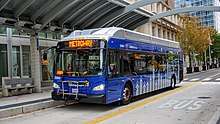Metrobus (Washington, D.C.)
Metrobus is a bus service operated by the Washington Metropolitan Area Transit Authority (WMATA). Its fleet consists of 1,595 buses covering an area of 1,500 square miles (3,900 km2) in Washington, D.C., Maryland and Virginia.[2] There are 269 bus routes serving 11,129 stops, including 2,554 bus shelters.[2] In 2016, Metrobus provided approximately 123.6 million trips.[2] On a typical weekday in June 2017, it provided more than 390,000 trips.[3]
 Washington Metropolitan Area Transit Authority BRT buses that are painted in the newer Local and Express paint schemes. | |
| Parent | WMATA |
|---|---|
| Founded | February 4, 1973[1] |
| Headquarters | Washington, D.C. |
| Locale | Washington Metropolitan Area |
| Service area | Washington Metropolitan Area |
| Service type | Local, express, limited-stop, bus rapid transit |
| Routes | 269[2] |
| Stops | 11,129[2] |
| Fleet | 1,595[2] |
| Daily ridership | 390,746[3] |
| Annual ridership | 123,675,724 (2016)[2] |
| Fuel type | Diesel, Diesel-electric Hybrid, CNG, Electric |
| Operator | WMATA |
| General manager | Paul Wiedefeld |
| Website | www.wmata.com |
History
Metrobus was founded on February 4, 1973, after acquiring DC Transit, Washington, Virginia and Maryland Coach Company (WV&M), Alexandria, Barcroft and Washington Transit Company (AB&W) and the Washington Marlboro and Annapolis Motor Lines (WM&A) to combine into Metrobus.[1][4] During its foundings, WMATA drops transfer charges, extends senior citizen discounts region-wide and begins selected fare reductions on routes formerly served by the different carriers at different rates. WMATA also unifies a new bus livery with red, white and blue paint scheme and purchases 620 buses from AM General with the last buses being delivered in 1974.[5]
Fares
NOTE: all fares are free since mid-March 2020 due to the ongoing COVID-19 outbreak, up to further notice.
As of June 25, 2017, the Metrobus fare structure is as follows for cash and SmarTrip:[6]
- Local bus routes within the District of Columbia, Central Maryland and Northern Virginia: $2.00
- Express bus routes (11Y, 17B, 17G, 17H, 17K, 17L, 17M, 18G, 18H, 18P and 29W): $4.25
- Express Airport bus routes (5A and B30): $7.50
Discounts are available for senior citizens, people with disabilities and D.C. students.
Up to two children, per paying adult, under 5 years of age ride for free. Children at least 5 years of age pay adult fare.
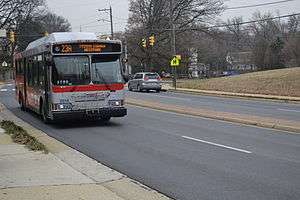
All Metrobuses have SmarTrip card readers which automatically deduct the correct fare from a rider's SmarTrip card (including transfer credit).
Metrobus issued paper transfers until January 4, 2009. Transfers are now currently attainable only through SmarTrip cards.
On June 27, 2010, the transfer window was reduced from 3 hours to 2 hours.[7]
Fleet

On July 4, 2018, WMATA awarded a 5-year contract to New Flyer for up to 694 buses, order consist of forty-foot CNG, forty-foot clean diesel, sixty-foot CNG, and sixty-foot diesel heavy-duty transit buses.[8] These new buses will replace Metro's older Orion V buses, which were delivered in 2000, and Metro's older Orion VII CNG buses, which were delivered in 2005–2006. Red/Silver painted buses will be used on local routes and Blue/Silver buses will be used on limited stop routes. These buses will have either Local or MetroExtra on the top of each side of the bus for easy identification.[9]
WMATA is adding a total of 533 hybrid buses to replace its diesel bus fleet. Each new "New Flyer Xcelsior XDE40" bus costs $571,737 and is expected to break down less frequently as well as offer greater fuel economy. With the latest purchase of 152 hybrid buses for $89.3 million from New Flyer of America, WMATA's Metrobus fleet will consist of 297 diesel buses, 800 hybrid buses and 458 natural gas fueled buses.[10] Additionally, WMATA placed an order for 110 new buses from New Flyer on September 18, 2019.[11]
Divisions
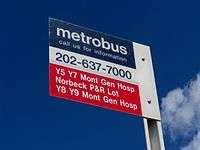

There are 10 divisions (a.k.a. depots) in the Metrobus system.[12]
| Division | Location | Areas served | Capacity | Notes |
|---|---|---|---|---|
| Andrews Federal Center[13] | 38.829570°N 76.882310°W | Southwest DC, Prince George's County | 175 | Opened June 23, 2019[14] |
| Bladensburg | 38.922930°N 76.970020°W | Northeast and Southeast DC | 257 | Plans to be rebuilt.[15] |
| Cinder Bed Road[16] | 38.743190°N 77.183030°W | Fairfax County | 160 | Opened 2018, operated by the private contractor TransDev[17] |
| Four Mile Run | 38.843040°N 77.053700°W | Arlington County, Fairfax County, City of Alexandria | 218 | Handles West Ox Division routes on the weekends |
| Landover | 38.936230°N 76.875320°W | Prince George's County | 210 | |
| Montgomery | 39.047630°N 77.109230°W | Montgomery County | 240 | |
| Southern Avenue Annex | 38.872710°N 76.931990°W | Southeast DC, Prince George's County | 103 | Operates Weekdays only, formerly known as "Prince George's" Division up until 1989 |
| Shepherd Parkway | 38.815040°N 77.017170°W | Southeast and Southwest DC, Prince George's County | 250 | Opened in 2012 |
| West Ox | 38.852840°N 77.372760°W | Arlington County, Fairfax County | 100 | Operates Weekdays only, shared with Fairfax Connector |
| Western | 38.958530°N 77.085510°W | Northwest DC | 138 |
Closed depots
| Division | Location | Areas served | Capacity | Notes |
|---|---|---|---|---|
| Arlington | 38.878120°N 77.108963°W | Arlington County, Fairfax County | Closed in 2009, replaced by West Ox Division | |
| Northern | 38.946860°N 77.032380°W | Northwest DC | 175 | Former trolley barn for the Capital Traction Company; closed June 23, 2019 due to structural issues, planned to be rebuilt[18] |
| Southeastern | 38.876080°N 77.007870°W | Southeast and Southwest DC | Closed in 2008; operations moved to Southern Avenue until the Shepherd Parkway Division opened in 2012 | |
| Royal Street | 38.810950°N 77.042800°W | Fairfax County, City of Alexandria | 83 | Closed in 2014, Replaced by the Cinder Bed Division; Demolished in January 2020.[19] |
Routes
Numbering
Most Metrobus routes follow the rules below:[20]
- Metrobus routes in Washington, D.C. have either a two digit number (31, 42, 64, etc.) or a letter followed by a number (A2, S2, X8, etc.)
- Metrobus routes in Montgomery County, MD have a letter followed by a number (C4, Q4, Z6, etc.)
- Metrobus routes in Prince George's County, MD have a letter followed by two numbers (F12, J12, P12, etc.)
- Metrobus routes in Northern Virginia have one or two numbers followed by a letter (1A, 16C, 29N, etc.)
Odd-numbered routes are typically part-time variants of even-numbered routes.
Richmond Highway Express
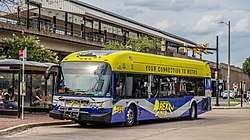
Richmond Highway Express, a.k.a. "REX", is a Limited-Stop bus line that operates between King Street–Old Town station and Fort Belvoir along the Richmond Highway corridor in Fairfax County, Virginia. The current "REX" fleet consists of twelve 2009 New Flyer DE40LFA diesel-electric hybrid buses (6301–6312) painted in a blue-and-gold paint scheme, all of which operate out of the Cinder Bed Road division. REX began service on September 26, 2004, replacing parts of the now-former route 9A (which operated between Huntington and Pentagon stations until it was eliminated June 26, 2016).[21] The original REX bus fleet consisted of twelve now-retired 2000 Orion 06.501 (VI) buses wrapped (but not painted) in blue-and-gold paint scheme (2073–2084) before the aforementioned Orion 07.501 CNG buses arrived in 2006. The second "REX" fleet consisted of 12 2006 Orion 07.501 (VII) CNG buses (2674–2685) painted in the blue-and-gold paint scheme, until they were all repainted between June and August 2014. The third "REX" fleet were consisted of 12 2010 New Flyer DE40LFA diesel-electric hybrid buses (6550–6561) before being repainted from June 2018 back into the Red Local Scheme due to the units being rehabilitated.
MetroExtra

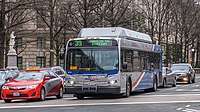
MetroExtra is a limited-stop Metrobus service, which operates on Metrobus lines that need extra service with faster trips. MetroExtra started service on March 19, 2007 with the 79 that operates between the Silver Spring and Archives stations on the 7th Street/Georgia Avenue corridor.[22]
Metroway
Metroway is a bus rapid transit (BRT) service that began on August 24, 2014. The first phase is the Crystal City/Potomac Yard Transitway, which operates on Route 1 in Arlington and Alexandria, Virginia.[23] It is a 5-mile (8.0 km) corridor with 33 platforms and 20 stations located between Pentagon City and Braddock Road.[24] The first 0.8 mile segment in Alexandria runs on a transit lane only. The Arlington County segment began construction in the summer of 2014 and opened April 17, 2016. Metroway originally operated between the Braddock Road and Crystal City stations and was expanded to Pentagon City in April 2016.[25] Thirteen 2016 New Flyer Xcelsior XN40 CNG buses (2981–2993) operate with the blue-and-white Metroway livery. The original Metroway fleet consisted of thirteen 2014 NABI 42 BRT diesel-electric hybrid buses (8002–8014) until they were all repainted in December 2016. The Metroway service, which is operated by Metrobus' Four Mile Run bus division, features dedicated bus lanes, transit signal priority, real-time information, custom designed shelters and stations, as well as near-level boarding at station platforms. A Metroway fare costs the same as Metrobus, which is $2.00 (using cash & SmarTrip).
Incidents
See also
| Wikimedia Commons has media related to Metrobus (Washington, D.C.). |
References
- "Washington Metropolitan Area Transit Authority Compact" (PDF). www.wmata.com. Washington Metropolitan Area Transit Authority. Retrieved March 28, 2018.
- "Metro Facts 2017" (PDF). www.wmata.com. Washington Metropolitan Area Transit Authority. 2017. p. 5. Archived from the original (PDF) on July 2, 2018. Retrieved March 28, 2018.
- "Metrobus Monthly Ridership: June 2017 — Preliminary" (PDF). www.wmata.com. WMATA. June 2017. Retrieved March 28, 2018.
- "History". Retrieved December 8, 2019.
- "Metro History" (PDF). WMATA. Archived from the original (PDF) on June 27, 2008. Retrieved December 8, 2019.
- "June 25, 2017 Fare and Service Changes Brochure" (PDF). www.wmata.com. Washington Metropolitan Area Transit Authority. Retrieved March 28, 2018.
- "Fare adjustments take effect Sunday" (Press release). WMATA. June 25, 2010. Retrieved March 28, 2018.
- "WMATA upgrades fleet with up to 694 new buses from New Flyer/". www.newflyer.com. New Flyer. July 4, 2018. Retrieved July 6, 2018.
- "Metro begins express bus service and other improvements to 16th Street Line" (Press release). WMATA. March 30, 2009. Retrieved March 28, 2018.
- Hedgpeth, Dana (May 11, 2011). "Metro is putting its mind to saving energy". The Washington Post. p. B1.
- "WMATA orders 110 buses from New Flyer". Mass Transit. Retrieved September 24, 2019.
- "2017 Metrobus Fleet Management Plan" (PDF). Retrieved October 26, 2019.
- "Hensel Phelps Awarded WMATA Andrews Federal Bus Garage". Hensel Phelps. June 19, 2014.
- "Metro opens new Andrews Bus Garage, ends cash-free pilot effective with bus service changes June 23". Retrieved October 25, 2019.
- "Proposed Reconstruction of the Bladensburg Bus Garage". Retrieved October 25, 2019.
- "WMATA Cinder Bed Road Division". Wendel Companies. Archived from the original on March 5, 2016.
- "Metro awards contract for new bus facility in Virginia". www.wmata.com. WMATA. August 2, 2018.
- Dodds, Alex. "WMATA plans to rebuild its 14th Street bus garage with retail, and keep its diesel fleet for now". Greater Greater Washington. Retrieved June 25, 2019.
- Guerguerian, Rosemary (December 11, 2019). "Bye, Bye Bus Barn". The Zebra. Retrieved May 28, 2020.
- Rowlands, DW; Alpert, David (September 20, 2018). "8W? 30N? U7? How Metrobus numbers came to be". Greater Greater Washington. Retrieved January 27, 2019.
- Fehr, Stephen (August 19, 2004). "Bus Service to Expand, Shift". The Washington Post. Retrieved May 2, 2019.
- "New MetroExtra provides faster Metrobus service along Georgia Avenue" (Press release). Washington Metropolitan Area Transit Authority. March 19, 2007. Retrieved May 2, 2019.
- Lazo, Luz (August 23, 2014). "Metroway, the region's first bus rapid transit, to debut in Northern Virginia". The Washington Post. Retrieved December 18, 2014.
- "Route". Metroway. Retrieved December 18, 2014.
- Smith, Max (April 17, 2016). "New bus-only lanes open along Jefferson Davis Highway". WTOP. WTOP. Retrieved April 18, 2016.
